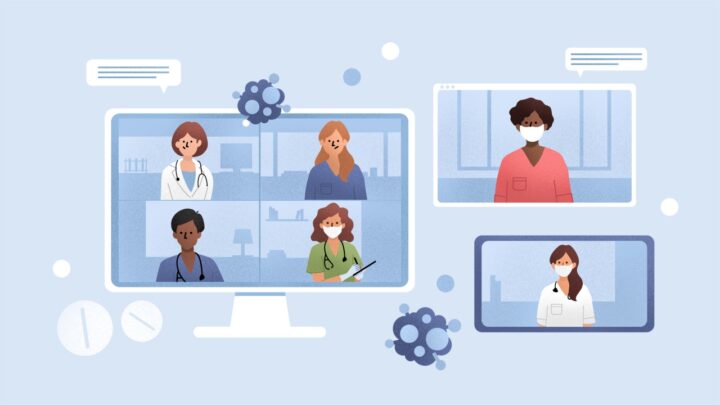
Collaborative education models unite healthcare professionals (HCPs), sectors and educational institutions to enhance clinical skills, foster research and improve patient outcomes.1 These partnerships offer opportunities for training, professional growth and interdisciplinary collaboration, which go a long way to shape the future of medicine.
Their real-world impact underscores the importance of these partnerships. According to a recent Sermo poll, 92% of surveyed physicians believe that collaborations with educational institutions improve patient care.1 Yet, they’re not without challenges, and 38% of Sermo doctors say they have a lack of time and resources to collaborate effectively within education.1
So, what makes educational partnerships effective, and how can they be optimized for the best healthcare outcomes? This article delves into the benefits of collaborative education models, the obstacles they face and strategies for success.
Understanding collaborative education in healthcare

What is a collaborative approach in healthcare education?
A collaborative approach in healthcare education emphasizes interprofessional learning and teamwork, equipping professionals to deliver high-quality, patient-centered care.
Through interprofessional education (IPE), students from diverse healthcare fields train together, developing skills to work effectively in multidisciplinary teams. This foundation supports collaborative practice, where healthcare providers partner with patients, families, and communities to address complex medical needs.2
According to the WHO Framework for Action on Interprofessional Education, interprofessional collaboration is “one of the most promising solutions2” for overcoming the global healthcare professional shortage and building a competent and adaptable workforce.2 This is because the approach drives equity and innovation, creating a healthcare workforce ready to tackle global challenges through shared learning, mutual respect, and team-based care.
What are collaborative education models?
These models take several forms, each tailored to specific goals:
- Training programs for medical students and residents
- These hands-on clinical rotations and mentorship opportunities offer a mix of academic learning and practical application—for example, residency programs where interdisciplinary teams manage real-world cases.
- Continuing medical education (CME) courses
- These CME courses help physicians stay updated on the latest advancements.3 Many Sermo members believe them to be incredibly important for professional growth: 46% of surveyed physicians identified CME as the most beneficial form of collaboration.1
- Collaborative research projects
- These joint initiatives address pressing medical challenges, from developing novel treatments to advancing public health interventions. For example, HARMONY PLUS uses big data, AI and collaboration to enhance blood cancer care, which is helping to accelerate treatment development.4
- Joint public health initiatives
- These programs address community health needs, such as vaccination drives or CPR workshops. They help to reinforce the importance of healthcare education in improving population health.
Benefits of interprofessional collaboration in healthcare

Why is collaboration important for doctors?
Improved professional growth
Among surveyed physicians, 29% collaborated primarily for professional development, with 46% identifying CME courses as the most beneficial and 35% emphasizing medical student or resident training programs as valuable.1
These initiatives help doctors to upskill and undertake practical learning. An internal medicine physician reflected, “These partnerships have allowed me to contribute to impactful projects, exchange knowledge and stay current with innovative educational practices.5”
Collaborative education enhances individual expertise while creating a network-wide culture of knowledge sharing. Physicians benefit from personal professional growth, access to second opinions, and keeping their knowledge up to date, which means they can more confidently address evolving healthcare challenges.
Better patient outcomes
Educational collaboration improves patient care by bridging the gap between theoretical knowledge and clinical application. 92% of surveyed physicians believe partnerships with educational institutions enhance the quality of patient care.1
This is especially evident in programs that emphasize interdisciplinary collaboration. A family medicine physician noted, “Collaborative education models in healthcare are incredibly important. I believe these partnerships enhance clinical skills and improve patient care by fostering a culture of continuous learning and innovation.5”
When physicians from various specialties exchange insights, whether through collaborative research projects or joint public health initiatives, these efforts enhance the skills of all participants, improving clinical decision-making and ultimately leading to better patient outcomes.
Heightened knowledge across disciplines
One of the most significant advantages of collaboration is the opportunity to share knowledge and expertise. These exchanges help to hand down knowledge between generations of HCPs and share knowledge between unique specialties.
A physician shared, “I have participated in and given the opportunity for medical students to observe how I conducted my private practice, giving them hands-on aspects of patient care and involvement in the business side. It particularly helps them in career decision-making.5”
Collaboration also breaks down barriers. An obstetrics physician noted, “These models break down traditional barriers between specialties, making communication smoother and care more unified.5” One example is knowledge sharing between public services, as one Internal Medicine Sermo member notes, “I have collaborated in mutual exchange with the firefighters of my city, offering CPR workshops and they train us in natural disasters.5”
Collaborative education brings HCPs together, sharing knowledge across fields and even with public sectors like firefighters. This teamwork boosts innovation, builds new skills and helps professionals adapt to different approaches. By breaking down barriers, it creates a more connected healthcare system with better patient care strategies that everyone can rely on.
Common barriers to effective collaboration

Time constraints
For many physicians, finding the time to participate in collaborative education remains a significant hurdle. 38% of surveyed physicians identified a lack of time and resources as the biggest challenge to fostering effective partnerships.1
One internal medicine physician shared, “Working with students helped keep me on my toes. Unfortunately, my patient load was so high that I couldn’t give them the attention and time they needed.5”
Ultimately, without adequate time, the full benefits of collaborative programs, both for professional growth and patient outcomes, are difficult to achieve.
Resource limitations
Limited funding and logistical challenges further constrain collaboration efforts. 27% of physicians cited difficulty aligning schedules and goals, while 23% pointed to insufficient funding for collaborative programs as a critical barrier.1
An orthopedic surgeon stated, “Without adequate funding, any discussion is useless; politics and management have always thought of healthcare as a cost and not as an investment… everything else is just chatter.5”
When it comes to education, insufficient funding and misaligned schedules restrict opportunities for innovation and limit access to educational partnerships.
Institutional barriers
Bureaucracy and resistance to change often complicate collaboration between institutions. 10% of surveyed physicians identified limited access to partnerships as a challenge.1
One physician noted, “Such collaborative programs are very helpful once implemented, but it’s quite a difficult task due to organizational obstacles.5”
Another emphasized, “Maintaining professional relationships while integrating educational and clinical practices poses several challenges due to financial constraints, institutional culture and regulatory standards.5”
These hurdles discourage participation and stifle efforts to integrate collaborative education into clinical practice.
Variability in implementation
Collaboration opportunities differ significantly between academic institutions and private practices.
An emergency medicine physician observed, “Academic practice often does not align with private practice. Academia is usually overburdened with bureaucracy and red tape, making it difficult to forge meaningful relationships.5”
This inconsistency creates disparities in access to collaboration, leaving private practitioners at a disadvantage.
Strategies for the future of educational collaboration in healthcare

Enhancing collaboration in continuing education for doctors requires a focus on innovation, inclusivity and addressing key barriers in the following areas:
- Technology: E-learning for doctors platforms, telemedicine and shared databases make it easier for HCPs to access education and collaborate, even with busy schedules. These tools support ongoing learning and connect professionals across different locations.
- Funding and structural support: Providing resources and simplifying processes can help overcome institutional challenges. Formal programs, like mentorship initiatives and quality improvement projects, create clear pathways for collaboration and support professional growth.
- Interprofessional education in healthcare: Expanding interdisciplinary collaboration in healthcare is crucial. Programs that involve students working in diverse teams to solve clinical cases build teamwork skills and better prepare future physicians for complex patient care. One physician noted, “Programs in which students work in multidisciplinary teams are good practice.5”
- Research: Placing greater focus on research and public health initiatives is vital. Collaborative research projects and public health campaigns advance medical knowledge while tackling critical community health challenges.
- Protected time: Institutions should provide dedicated time for teaching and research to support collaboration.
- Learning new languages: In the United States, Spanish can be one of the best languages for doctors to learn. It is the second most widely spoken language in the country, so there is high demand for English & Spanish-speaking HCPs.6
Collaborative healthcare education is transformative
With 92% of surveyed physicians recognizing its impact on patient care1, the value of collaborative healthcare education is undeniable.
However, challenges like time constraints, funding and institutional barriers must be addressed to unlock its full potential.
By using technology, allocating resources and formalizing programs, the future of educational healthcare collaboration can thrive.
Ready to shape the future of healthcare education?
Join over 1 million physicians on Sermo to share insights, collaborate on innovative solutions and explore opportunities for professional growth.














